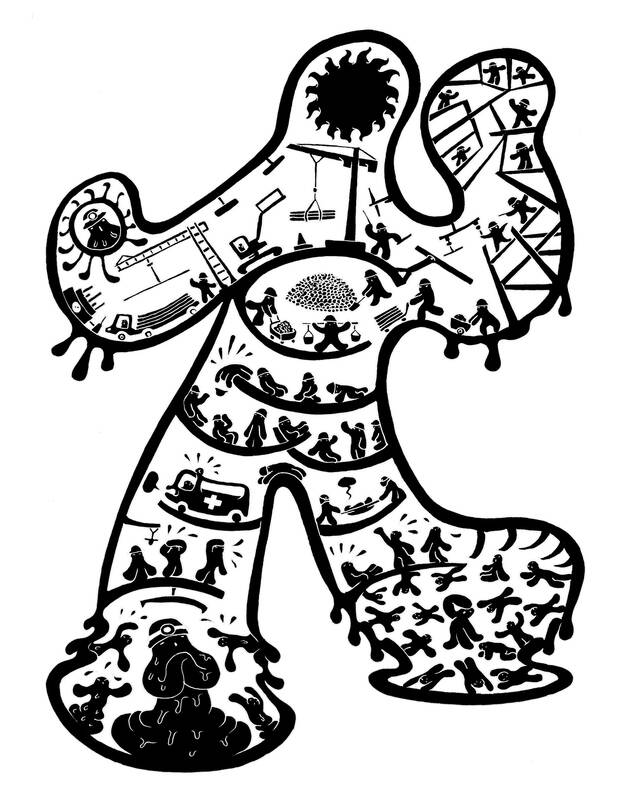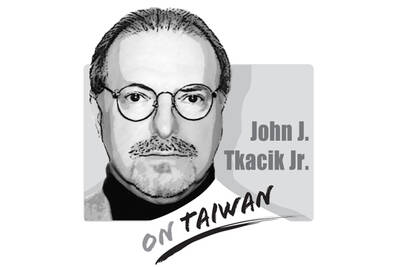Food delivery driver John Jay Chan has had no protections from the record-breaking heat waves that have hit the Philippines, but he must continue to work nine-hour days to provide for his family.
“We understand that the nature of our work means we’re exposed to extreme heat,” said Chan, a 30-year-old father of two, who has been a motorbike gig worker for six years.
Some of Chan’s colleagues have experienced mild heat stroke or elevated blood pressure while working in temperatures that have exceeded 45?C.

Illustration: Mountain People
“But until now, we haven’t been monitored by the government for heat-related illnesses or deaths, so the lack of data means we’re not a priority,” Chan said.
From the Philippines to India to Mali, a lack of reliable data on heat-related deaths is undermining efforts to mitigate the risk of extreme heat and provide better protection for the most vulnerable, such as outdoor migrant and gig workers.
Globally, 2.41 billion workers, or 70 percent of the world’s workforce, are exposed to excessive heat, with people in Africa, Arab states and the Asia-Pacific region facing the highest exposure, according to a July report by the International Labour Organization (ILO).
This causes nearly 19,000 deaths a year, the ILO said.
“The number of workers suffering the consequences of excessive heat is alarming, and occupational safety and health protections have struggled to keep up,” the ILO said.
Collecting accurate data to inform government policy on reducing exposure to extreme heat is more urgent than ever as climate change pushes global temperatures and heat-death tolls higher.
Last year was the hottest on record, and July 21 was the hottest day ever recorded as heat waves scorched large swaths of the US, Europe and Russia.
“In the context of climate change, we see longer extreme-heat days that last longer through the night, and so people won’t have a break,” said Tarik Benmarhnia, an environmental epidemiologist at the University of California, San Diego.
“Health professionals don’t fully realize how this is a big issue,” he said.
In the Philippines, where a two-week heat wave in April forced schools to shut, seven heat-related deaths and 77 heat-related illnesses were reported from January to May, Philippine Department of Health data showed.
Labor union activist Lucas Ortega said such figures do not reflect the risk of heat stress workers face.
“We know we have thousands of delivery riders, construction and maintenance workers, street cleaners and workers from different industries, but we don’t know how many of them were exposed to extreme heat,” said Ortega, a spokesperson for the Center of United and Progressive Workers in the Philippines.
Accurate data on heat-related mortality are difficult to obtain because health authorities do not attribute deaths to heat specifically, but rather to the illnesses exacerbated by high temperatures, such as cardiovascular and kidney issues.
This makes heat a “sneaky and silent killer,” Benmarhnia said.
“In the vast majority of situations, heat is going to actually trigger a lot of complications, and that would be the case for people who already have some sort of comorbidity [or] underlying chronic diseases,” he said.
Death certificates stating heat as a direct cause are rare, health researcher Barrak Alahmad said.
“Gathering data typically involves identifying indirect causes and correlating this with temperature on very hot days and seeing excess deaths on a typical day,” said Alahmad, a research fellow at the Department of Environmental Health at Harvard T.H. Chan School of Public Health.
But in many low-income nations, mortality data are often reported on a weekly or monthly basis and not daily, he said.
It means heat-related deaths are undercounted, typically overlooking thousands, if not tens of thousands, of deaths.
“Even countries with massive resources still struggle to identify heat deaths,” Alahmad said.
In India, the lack of accurate recording of heat-related mortality is a “public health failure,” said Dileep Mavalankar, a professor and former head of the Indian Institute of Public Health, a private university in Gandhinagar.
It is projected that more than 1.5 million Indians would die each year from extreme heat by 2100, according to 2019 research by the Climate Impact Lab.
Since the start of India’s summer on March 1 through June 18, at least 110 confirmed heat-related deaths occurred, when temperatures in the capital, New Delhi, soared to almost 50?C.
That figure is only “the tip of the iceberg,” said Mavalankar, who helped implement South Asia’s first Heat Action Plan in Ahmedabad in 2013, after the city saw more than 1,300 deaths in a 2010 heat wave.
“Political will and understanding are totally missing at the moment. There is also no public pressure, or accountability pressure or auditing pressure,” he said.
Without data, “no public action will be taken... This is long-standing neglect,” he added.
The Indian National Centre for Disease Control (NCDC), which records heat-related deaths, did not respond to repeated requests for comment.
While the NCDC published a set of guidelines to help hospitals identify and categorize heat-related deaths, Mavalankar wants the NCDC to require all hospitals to report all deaths daily on its online portal, rather than leave it as a voluntary practice.
Heat officers should be assigned to every city to record daily deaths from crematoriums and cemeteries, and publish them with comparative data, he said.
“These fixes, including the all-cause mortality data, are easily doable at no major costs,” Mavalankar said.
At Mali’s Gabriel Toure Hospital in the capital, Bamako, doctors said 102 patients died over four days in April compared with 130 deaths recorded in the entire month last year.
They linked the spike to a deadly heat wave, and resulting power cuts, that hit Mali and other nations in the African Sahel, including Senegal, Guinea, Mali, Burkina Faso, Niger, Nigeria and Chad.
Official death tolls from the heat wave across the Sahel region are undercounts, according to World Weather Attribution (WWA), a group of researchers who study the link between heat and climate change.
“Many places lack good recordkeeping of heat-related deaths, therefore currently available figures are likely an underestimate,” the WWA said in a statement after the heat wave.
Tunde Ajayi, a Nigerian epidemiology and environmental health expert, said heatstroke in hospital records and death certificates is often reported as a secondary cause of death in African health settings.
“We need to mine the data for the cause of death right from hospital records to inform data for the health ministry and other agencies,” Ajayi said.
Currently most of the research on heat-related deaths is being conducted in the US, Europe and Australia.
Benmarhnia sees “a paradox,” in which most heat-related deaths are occurring in places with the least data, especially Sub-Saharan and northern Africa.
“These heat days are just going to become the norm. We shouldn’t be surprised when there is another heat event or another record that is broken,” Benmarhnia said.
A 50-year-old on Wednesday last week died while under anesthesia at a Taipei cosmetic clinic shortly after undergoing a penis enlargement procedure. The surgeon was arrested for suspected medical malpractice, again bringing to the surface shortcomings in the regulation of cosmetic medicine. Media reports said the clinic owner and surgeon, surnamed Ting (丁), was previously convicted of negligent homicide for a postsurgical death and had been charged with coercion and aggravated assault after allegedly stopping a patient from calling for an ambulance. He had also been fined for failing inspections and had allegedly permitted people without medical licenses to assist

It was most annoying last week to read Chairman Xi Jinping’s (習近平) fulsome encomium to the People’s Liberation Army during the Eightieth Anniversary celebrations of victory over Japan in World War II. Comrade Xi’s soaring rhetoric was stuffed with “martyrs, sacrifice, solemnity and unwavering resolve” in praise of the “Chinese People’s War of Resistance Against Japanese Aggression and the World Anti-Fascist War.” His aspirations overflowed with “world peace” and love of the United Nations, of which China is a founding member. The Liberation Army Daily said that every word from General Secretary Xi Jinping “resounded in his powerful voice, illuminating the
An American Institute in Taiwan (AIT) spokesperson on Saturday rebuked a Chinese official for mischaracterizing World War II-era agreements as proving that Taiwan was ceded to China. The US Department of State later affirmed that the AIT remarks reflect Washington’s long-standing position: Taiwan’s political status remains undetermined and should only be resolved peacefully. The US would continue supporting Taiwan against military, economic, legal and diplomatic pressure from China, and opposes any unilateral attempt to alter the “status quo,” particularly through coercion or force, the United Daily News cited the department as saying. The remarks followed Chinese Minister of Foreign Affairs
OpenAI CEO Sam Altman recently sat down for an interview with former Fox News host Tucker Carlson in which he openly acknowledged that ChatGPT’s model behavior is indeed influencing the entire world, and that he himself is responsible for the decisions related to the bot’s moral framework. He said that he has not had a good night of sleep since its launch, as the technology could bring about unpredictable consequences. Although the discussion took place in the US, it is closely related to Taiwan. While Altman worries about the concentration of power, the Chinese Communist Party (CCP) has already weaponized artificial